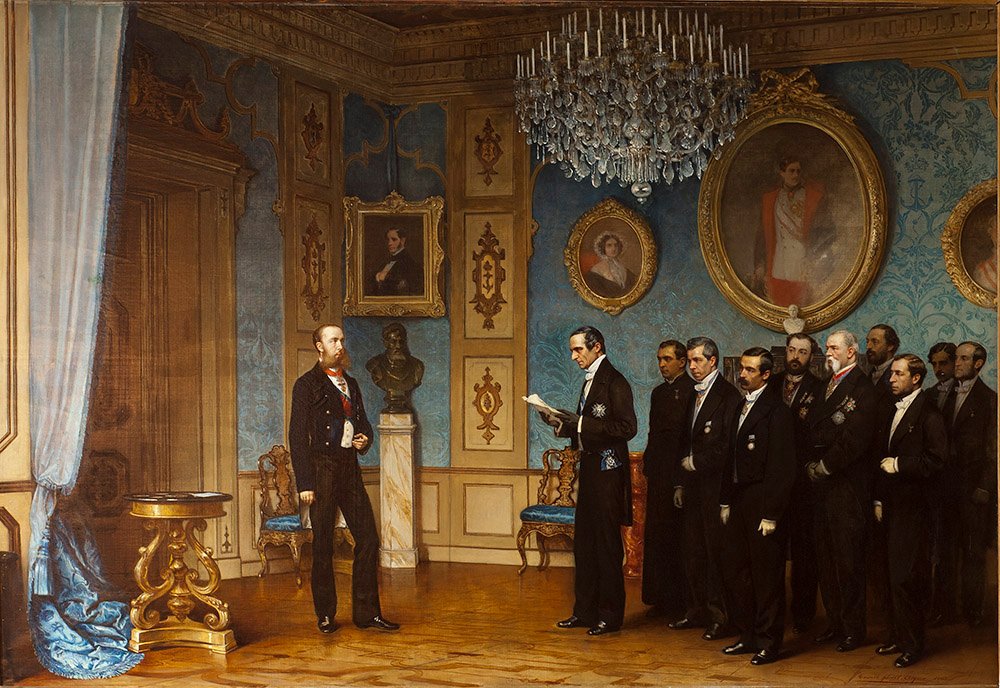If you wander through the stately rooms of Miramare Castle, perched above the Adriatic in Trieste, you’ll feel something odd—and wonderful. There’s a clear split inside: cozy private spaces where life actually might have happened, and grand public rooms built to impress. I think this division tells us more than the portraits or the gilt.

Miramare Castle Floor Plan
You can find some floor plan on Castle official website.
Ground Floor – The Private Apartments
Stepping into the ground floor is like entering someone’s home (with serious budget for décor). Behind discreet doors lie the living quarters of Maximilian I of Mexico and his wife Charlotte of Belgium. The goal? Intimacy, nature, family. The sea is visible, the air smells of stone and salt and indoors there is wood, textile, books.
Maximilian’s Study (“The Cabin”)
One of the strangest rooms—and I mean that with admiration—is Maximilian’s study. It’s modelled on the cabin of his frigate Novara, the very ship he commanded on his world circumnavigation from 1857 to 1859. Lowered ceiling, wood panels all around, crowned anchors (naval symbol) and pineapples (weirdly rich symbol) carved everywhere. The naval motif is heavy: you can almost hear the creak of the deck below. It’s a bit incongruous in a palace setting—this ship-cabin aesthetic—but maybe that’s the charm. He wanted connection to the sea, to his naval identity, even in his study.
The Library
Next door (or nearby) is the library. Rows of bookshelves—the original layout preserved. Languages mixed. It shows the archduke weren’t just a naval buff but a reader, thinker. The walls lined with books in Italian, German maybe French; I imagine him here after the sea salt and wind, turning a page. The castle museum info confirms that many rooms still host mid-19th-century furnishings.
Charlotte’s Apartments
And then, Charlotte’s four elegant rooms: light-blue silk tapestries envelop the walls, soft atmosphere—contrast to the cabin’s wood paneling. The coats of arms of Habsburg-Lorraine and Saxe-Coburg-Gotha show the joining of dynasties. The furniture in Lombard style? A wedding present from the City of Milan. The detail makes you realise this room wasn’t just “nice for palace”, but tailored for her. The tone shifts: naval study → grand library → soft domestic suite.
First Floor – Reception Rooms
Upstairs, the mood changes drastically. It’s no longer about living, it’s about being seen. Big halls, sumptuous decoration, high ceilings, gilding. Public presence. I found it jarring (in a good way) when I climbed the stairs: from the intimate rooms into vastness.
The Throne Room
This is show-off central. The throne room has been restored to its original splendour. Huge paintings of Habsburg emperors line upper walls. Elaborate ceiling and wall paneling soak the room in authority. The contrast to downstairs is stark: private domestic → imperial statement. According to museum descriptions: the state rooms (first floor) are “sumptuous”.
The Audience Room
Here, deep-red wallpaper with gilded decorations, showcasing motifs: pineapples again (wealth), Mexican eagles holding serpents, crowned letters “MM” and “I” (Maximilian of Mexico, Emperor/First). The bay view adds another element: power surveying sea. The layering of meaning: imperial ambition + exotic motifs. It’s indulgent and fascinating.
The Chinese & Japanese Rooms
There’s also a detour into the exotic: rooms decorated in “Oriental” taste—Chinese and Japanese rooms. Influenced by 19th-century European aristocratic fascination with the Orient. Porcelain collections, Eastern-style furnishings, decorative objects collected during his travels. It’s a peek into the world beyond, imported inside the castle. The exotic is literally room décor.
The Seagulls Room & Music Room
The Seagulls Room: a ceiling painting of thirty-six seagulls holding scrolls with Latin mottos. You realize again: this place is full of symbolism—and the sea keeps creeping in. The Music Room: Charlotte’s pianoforte still sits there, a silent reminder of musical evenings the couple once shared. These are intimate notes hidden among grand halls.
Why I’m Still Thinking About It
Most castles blur together after a while—fancy rooms, old furniture, move along. But this split-level design actually tells you something. Downstairs they tried to live normal lives (as normal as royalty gets). Upstairs they performed being royalty. The whole building is basically two different buildings stacked on top of each other.
I kept noticing the pineapples carved everywhere. Once you spot the first one, you start seeing them in weird places. Some kind of wealth symbol that Maximilian was apparently obsessed with.
If You Go
It’s about 20 minutes from central Trieste, right on the water. The view from the promontory is worth it even if you skip the interior (but don’t skip the interior).
Start on the ground floor so you get the narrative arc—intimate to imperial. If you do it backwards it won’t make as much sense.
Budget at least two hours. We tried to rush through in 90 minutes and regretted it. The upstairs rooms have way more detail than you’d expect—ceiling paintings, Oriental collections, random symbolic decorations.
The preservation is genuinely good. Most of the furniture is original 1850s-1860s stuff, which apparently is unusual. So if you care about decorative arts or mid-19th-century interior design, this place delivers.
Cash only at the ticket counter, by the way. We had to find an ATM first.